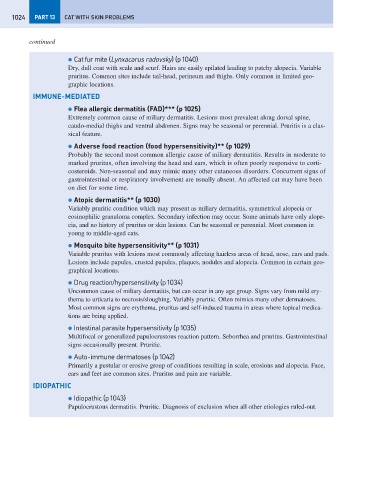Page 1032 - Problem-Based Feline Medicine
P. 1032
1024 PART 13 CAT WITH SKIN PROBLEMS
continued
● Cat fur mite (Lynxacarus radovsky) (p 1040)
Dry, dull coat with scale and scurf. Hairs are easily epilated leading to patchy alopecia. Variable
pruritus. Common sites include tail-head, perineum and thighs. Only common in limited geo-
graphic locations.
IMMUNE-MEDIATED
● Flea allergic dermatitis (FAD)*** (p 1025)
Extremely common cause of miliary dermatitis. Lesions most prevalent along dorsal spine,
caudo-medial thighs and ventral abdomen. Signs may be seasonal or perennial. Pruritis is a clas-
sical feature.
● Adverse food reaction (food hypersensitivity)** (p 1029)
Probably the second most common allergic cause of miliary dermatitis. Results in moderate to
marked pruritus, often involving the head and ears, which is often poorly responsive to corti-
costeroids. Non-seasonal and may mimic many other cutaneous disorders. Concurrent signs of
gastrointestinal or respiratory involvement are usually absent. An affected cat may have been
on diet for some time.
● Atopic dermatitis** (p 1030)
Variably pruritic condition which may present as miliary dermatitis, symmetrical alopecia or
eosinophilic granuloma complex. Secondary infection may occur. Some animals have only alope-
cia, and no history of pruritus or skin lesions. Can be seasonal or perennial. Most common in
young to middle-aged cats.
● Mosquito bite hypersensitivity** (p 1031)
Variable pruritus with lesions most commonly affecting hairless areas of head, nose, ears and pads.
Lesions include papules, crusted papules, plaques, nodules and alopecia. Common in certain geo-
graphical locations.
● Drug reaction/hypersensitivity (p 1034)
Uncommon cause of miliary dermatitis, but can occur in any age group. Signs vary from mild ery-
thema to urticaria to necrosis/sloughing. Variably pruritic. Often mimics many other dermatoses.
Most common signs are erythema, pruritus and self-induced trauma in areas where topical medica-
tions are being applied.
● Intestinal parasite hypersensitivity (p 1035)
Multifocal or generalized papulocrustous reaction pattern. Seborrhea and pruritus. Gastrointestinal
signs occasionally present. Pruritic.
● Auto-immune dermatoses (p 1042)
Primarily a pustular or erosive group of conditions resulting in scale, erosions and alopecia. Face,
ears and feet are common sites. Pruritus and pain are variable.
IDIOPATHIC
● Idiopathic (p 1043)
Papulocrustous dermatitis. Pruritic. Diagnosis of exclusion when all other etiologies ruled-out.

